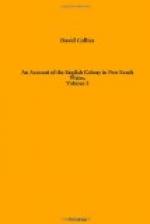In attempting to account for the cause that had operated to produce this change in the structure of the lower parts of the stems of these trees, Mr. Bass feels the utmost diffidence. He found that all his conjectures which were best supported by existing facts, led him to place them among petrifications; although no strict analogy could be seen between them and the subjects usually met with of this kind.
Admitting them, however, as petrifications, it is certain that there must once have existed a pond in which the petrifying water was contained; but the ground in their neighbourhood retained no positive traces of any such receptacle. There were, indeed, near them, some few lumps or banks consisting of sand, and a little vegetable earth which was held together by dead roots of small trees, and elevated above the rest of the ground, to the height of five, six, or eight feet; but the relative position of these with each other was so confused and irregular, that nothing but the necessity of a once existing reservoir could ever lead any one to conjecture that these might have been parts of its bank. Mr. Bass, however, rather concluded that this must have been the case, and that the remainder of the bank had been torn away, and the pond itself annihilated by some violent effort of an unknown power.
Notwithstanding the narrow limits of the island, abundance of small kangaroos were found to inhabit its brushy parts; but so many had been destroyed by the people of the Sydney Cove, that they had now become scarce.
The sooty petrel had appropriated a certain grassy part of the island to herself, and retained her position with a degree of obstinacy not easily to be overcome. For although it so happened, that the storehouse for the wrecked cargo was erected upon the spot, and the people for more than a year drew the favourite part of their food from these birds, and were besides continually walking over their habitations, yet at the end of that time the returning flights in the evening were as numerous as they had been observed to be upon their first arrival.
When Mr. Hamilton, the commander of the Sydney Cove, quitted the house, he left two hens sitting upon their eggs, some breeding pigeons, and a bag of rice; but no traces were now to be discovered either of the birds or their food. It is probable, that so long as this little colony continued within doors, it did well; but that, when forced by its necessities to go abroad in quest of food, it fell a quiet sacrifice to the rapacity of the hawks.
Several snakes with venomous fangs were found here; but, no person having been bitten by them, the degree of their power was unknown.
The water of the island was thought to have been injurious to the health of the people of the Sydney Cove. It was supposed to contain arsenic, which was highly probable from an experiment that was made with the metallic particles, which were taken to be tin. A large fume of what bore many marks of arsenic arose from the crucible during the time of smelting it. Water was very scarce while these people were upon the island; but, owing to some unusual falls of rain, several little runs and swamps were found by Mr. Bass; and a low piece of ground where they had deposited their dead was now a pond of an excellent quality.




